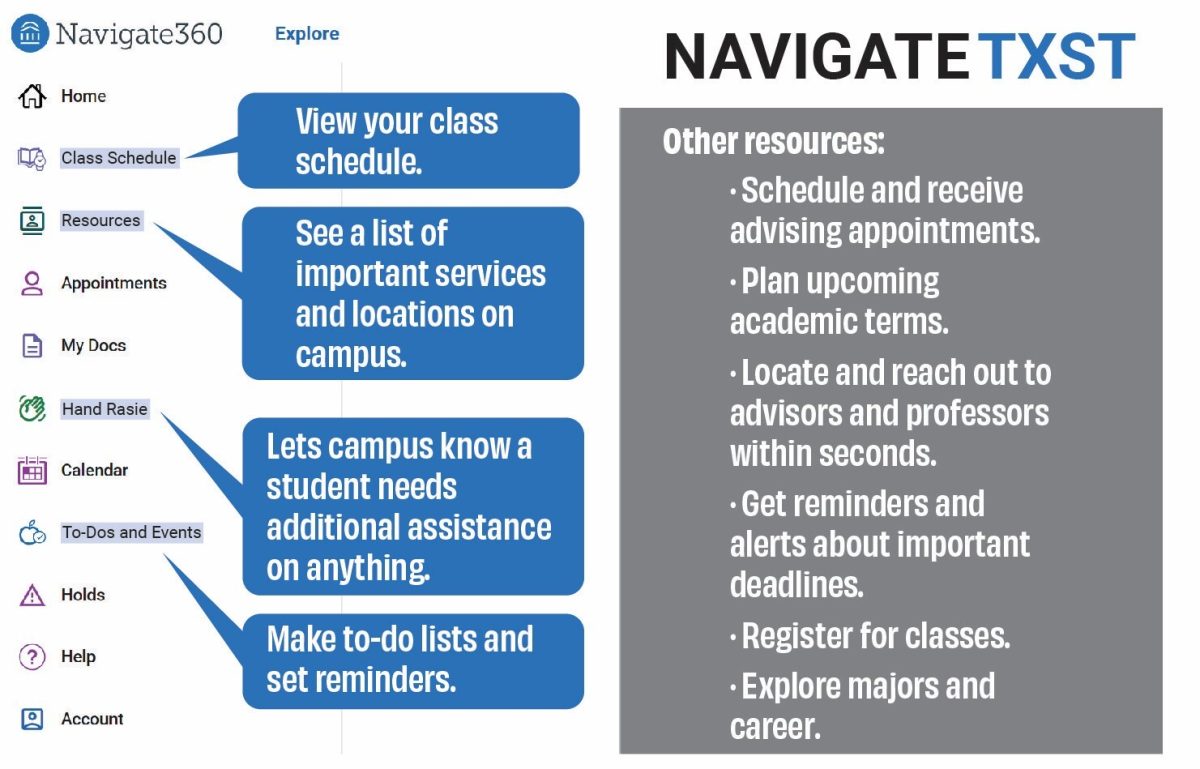Texas State has been recognized by the Hispanic Outlook magazine as one of the Top 100 Colleges and Universities for Hispanic students. The university is recognized on the list for total undergraduate enrollment.
Due to the enrollment of Hispanic students, Texas State is categorized as a Hispanic-Serving Institution. However, some students are unaware as to what the university does with the status.
Ismael Amaya, Hispanic Policy Network president, believes the university has a responsibility to explain what being a Hispanic-Serving Institution means and how the status shapes Texas State.
“I do think we, as an institution, have an obligation to explain to our students, faculty, staff, families and community what it means to be an HSI, why it’s important and what difference it makes,” Amaya said.
The Hispanic Association of Colleges and Universities defines a Hispanic-Serving Institution as “colleges, universities or systems/districts where total Hispanic enrollment constitutes a minimum of 25 percent of the total enrollment. Total enrollment includes full-time and part-time students at the undergraduate or graduate level (including professional schools) of the institution, or both.”
According to the Office of Institutional Research, Hispanic students make up 35 percent of the student body at Texas State. The population of Hispanic students allows Texas State to meet the qualifications to hold its status as a Hispanic-Serving Institution, which opens the door for the university to apply for and receive funding.
Amaya explained being a Hispanic-Serving Institution allows the opportunity for certain funding, however does not guarantee it.
“Traditionally, what you hear is that the designation opens the door to apply for funding, but nothing is a given or automatic,” Amaya said. “We don’t get money for simply being an HSI, or we don’t get money for having 25 percent of the undergraduate students identifying as Hispanic. But, the school can apply for grants that can serve students, and even that is sometimes misunderstood.”
Grants received from the status are not exclusive to only Hispanic students, according to Amaya.
“If the university is awarded a grant, it is typically not going to be distributed or used towards benefiting Hispanic students only,” Amaya said. “The grants allow for a service or program that is open to students and, again, just by the numbers, we would expect to see Hispanic students benefit—just like any other student participating in or using the service funded by the grant. The grant/program administrators still need to ensure that they are reaching Hispanic students. The effectiveness of a program funded by funds available to Hispanic-Serving Institutions could reasonably be called into question if it is not minimally reaching a proportionate representation of the study body.”
Currently, the University College is home to three HSI grant programs: Mentoring and Academic Coaching, Career and Financial Education at Texas State and Del Mar College and IMPACT STEM Student Success and Texas State University.
Each program has provided resources to the university supporting the overarching goal of “strengthening institutional capacity to serve” Hispanic and low-income students, specifically, and all students, more generally. Each of these grant programs have been made possible through the university’s status as an HSI.
Daniel Brown, dean of the University College, believes the university’s HSI status has allowed for a significant positive impact at Texas State.
“These three HSI programs allow us to be innovative in our responses to student need for assistance and service,” Brown said. “They are focused on freshmen persistence and retention and graduation rate improvement, and will help us achieve overarching goals for student success at Texas State University. It is also exciting to see changes in our student success ecosystem at Texas State that have and are occurring due to the significant and positive impact of these Title V and Title III Hispanic-Serving Institutions grant programs.”
There have been many questions raised regarding the university’s responsibility to its Hispanic Students as an HSI.
Alex Molina, Student Government senator and executive assistant of Hombres Unidos, said the university has a responsibility to ensure its Hispanic students feel welcome on campus.
“Making Hispanic students feel safe and like they belong is the first step in making sure that the University retains them,” Molina said. “Giving Hispanic students the resources to stay in school and graduate is a main responsibility of the university.”
Molina also said the university should be more vocal in its solidarity when issues affect the Hispanic student community.
“Recently, with the removal of DACA, many students felt like the HSI wasn’t there to defend them,” Molina said.
Among total enrollment, Texas State was nationally ranked in five categories: fourth for Public Relations, Advertising and Communication Degrees for Hispanics; sixth for Visual and Performing Arts Degrees for Hispanics; 13th for Bachelor Degrees Granted to Hispanics; 30th for Master’s Degrees Granted to Hispanics and 31st for total Hispanic enrollment.
Hispanic Outlook is an information news source and a Hispanic educational magazine resource for the higher education community.
Why Texas State serves as a Hispanic-Serving Institution
September 20, 2017
Donate to The University Star
Your donation will support the student journalists of Texas State University. Your contribution will allow us to purchase equipment and cover our annual website hosting costs.
























